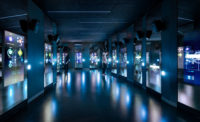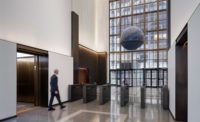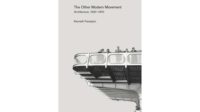Standard New York
Polshek Partnership raises the bar with a new benchmark in hotel design at the Standard New York.
Architects & Firms
New York, New York
Imagine New York City’s UN Headquarters building transported from its stuffy midtown location to a trendy downtown spot, kinked in the middle, rotated 90 degrees, and balanced over an elevated rail-line-cum-popular parkland and you’ve got the Standard New York. The latest incarnation of hotelier André Balazs’s chain of hip, “anything but standard” accommodations is the first he built from the ground up. His surprising choice of architect, Polshek Partnership, is not exactly a firm that’s in demand among the jet-set crowd. And though the Standard’s unapologetically Modern design shares little in common with the sinuous building shapes and exploding assemblies by more sought-after architects that have sprung up nearby, its fearless form—as if from a bygone era—is an attention-grabber nonetheless.
Packaged in rough, board-formed concrete and vast expanses of transparent glass, the Standard is sleek and gritty at the same time, echoing its Meatpacking District neighborhood, where high-end fashion showrooms and pricey art galleries have supplanted bloody butcher shops and no-frills warehouses. But the building draws inspiration from a surprising mix of influences beyond its immediate context, borrowing heavily from the architectural purism of the International Style on the one hand, and the flamboyant hotel design of Morris Lapidus—upon whose work those purists looked down—on the other.
“We designed from the inside out,” says Balazs, who collaborated closely with the Polshek team, led by Todd Schliemann, FAIA, a college friend. “We wanted the building to be all glass to make the rooms feel as expansive as possible, but we searched to find the right vocabulary. The result is a structure that is clearly Modern, but vaguely familiar.”
Schliemann quite literally uses a Corbusian vocabulary that is widely known, yet rarely referenced by contemporary designers, and calls the five massive, twisting concrete pylons that hoist the west side of the building the required 30 feet over the railway bed pilotis. (A single, sloped concrete pier, along which a tantalizing set of fire stairs runs, supports the building’s east end by the hotel entrance.)
References to Le Corbusier’s buildings and urban design are both intentional and incidental. While the zoning envelope only required that new construction over the raised railway essentially be a box with a hole in the middle to allow the tracks to pass through (like the older structures that were built over the High Line decades earlier), the completely as-of-right hotel rises heroically above the High Line—an elevated pedestrian zone slicing through the building reminiscent of Le Corbusier’s multistreet-level designs for La Ville Radieuse. But since Balazs purchased the site before the High Line was handed over to New York City, the Standard will likely be the only new construction to span across the recently opened park.
And as Corbusier did, Schliemann takes advantage of the rooftop as more than just an area for mechanical equipment, using minimal railings made from the same ultra-clear, low-iron glass of the facades to create a breathtaking deck, like that of a ship, with unobstructed, 360-degree vistas over the skyline and the Hudson River. (While an outdoor bar is planned, for now the roof, along with the rest of the building, is a popular location for photo shoots.)
The bent slab, however, was a Lapidus trick. “It allows us to squeeze in an extra room per floor, but more significantly, it provides a variety of view corridors while retaining as many views as possible of the Empire State Building,” explains Balazs, adding that the floor-to-ceiling glass “psychologically thrusts the guest out into the city.”
While the panoramic views from inside the Standard’s 337 rooms are spectacular, views into the hotel—perched over the High Line like an open book for all to see—can also get quite titillating as guests sometimes opt not to draw the curtains, prompting one local paper to refer to the building as the “eyeful tower.”
The guest rooms—spanning levels 4 through 17 above two 114-foot-long, 15-foot-tall steel trusses over the east pier and core shear walls—are laid out somewhat unconventionally. While rooms on one side of the corridor are oriented with the short end facing the window (as in most hotels), the rooms get flipped on the opposite side so that the long end opens up to more expansive views. The width of the building slab decreases accordingly, creating an elegantly thin exterior profile.
Those expansive views, along with the spare but smart interior design, add unmeasurable area to the moderately priced and moderately scaled rooms (averaging 250 square feet). New York–based interior designers Roman and Williams custom-designed much of the furniture and fixtures in the guest bedrooms and baths, and throughout the hotel and the Standard Grill—a one-story, reclaimed-brick-clad restaurant and bar underneath the High Line. Together with Shawn Hausman, who worked on the other Standard hotels, in downtown Los Angeles, Hollywood, and Miami Beach, the firm created interiors with styles that evolve chronologically as you ascend the building, encompassing Midcentury Modern and culminating in a soon-to-open lounge on the top, or 18th, floor, inspired by Warren Platner’s 1970s Windows on the World.
Back on the ground level, hotel guests and the public can sit and relax at the outdoor plaza near the hotel entrance, or gaze up at the steel underbelly of the High Line from the open-air beer garden behind the restaurant. Leaving so much of the 3⁄4-acre buildable site unbuilt may seem counterintuitive from a business point of view, but business at the Standard is good. While hotel occupancy rates nationwide have fallen to all-time lows, the Standard boasts near 90 percent occupancy since opening earlier this year. According to Balazs, “Value comes in creating an experience with the architecture.”
As Schliemann puts it, this is not “look at me” architecture. But you look anyway (and not just to catch a glimpse of the naked revelers inside). After years of training our eyes to take in the fantastical forms that have defined architecture at the turn of the 21st century, we’re left almost incredulous that such a simple and straightforward design can be so arresting, literally stopping people in the tracks as they meander along the High Line. That animated interaction with the High Line affirms the early-20th-century belief that good architecture, coupled with good urban planning, can transform society—in this case, converting a derelict part of the city into a popular pedestrian area topped off by a welcome new landmark.





